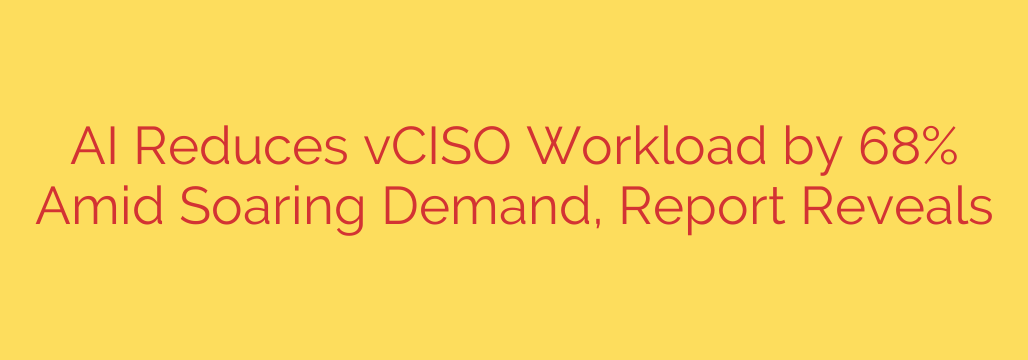
AI Transforms Cybersecurity Leadership: How Virtual CISOs Are Slashing Workloads by 68%
In today’s complex digital landscape, the demand for expert cybersecurity leadership has never been higher. Yet, a persistent skills gap and budget constraints make hiring a full-time Chief Information Security Officer (CISO) a challenge for many organizations. This has fueled the rise of the Virtual CISO (vCISO)—a flexible, experienced security expert available on a fractional basis.
Now, a new force is supercharging the effectiveness of these leaders: Artificial Intelligence. Recent findings show that AI-powered tools are reducing the tactical workload of vCISOs by a staggering 68%, freeing them up to focus on high-impact strategic initiatives that truly protect and empower businesses.
This isn’t about replacing human experts. Instead, it’s about augmenting their capabilities, allowing them to deliver more value than ever before.
Why the Demand for Virtual CISOs is Skyrocketing
Before diving into the impact of AI, it’s important to understand why vCISOs have become so essential. Businesses are facing unprecedented pressure from multiple fronts:
- A Sophisticated Threat Landscape: Cyberattacks are more frequent, automated, and damaging than ever before.
- Complex Regulatory Requirements: Navigating compliance frameworks like GDPR, CCPA, HIPAA, and PCI DSS requires deep expertise.
- The Cybersecurity Skills Gap: There simply aren’t enough qualified security professionals to meet the demand, driving up salaries and making recruitment difficult.
The vCISO model provides a powerful solution, offering access to top-tier C-level security guidance without the cost and commitment of a full-time executive hire. This makes robust security leadership accessible to small and medium-sized businesses (SMBs) that are often the most vulnerable.
The AI Effect: A 68% Reduction in Tactical Workload
The core challenge for any security leader is balancing urgent, day-to-day tasks with long-term strategic planning. This is where AI is proving to be a game-changer. By automating repetitive and data-intensive activities, AI is fundamentally changing the vCISO’s daily operations.
The dramatic reduction in workload is primarily driven by AI’s ability to handle tasks that traditionally consumed countless hours. Key areas of impact include:
- Automated Threat Detection and Analysis: AI algorithms can monitor network traffic, user behavior, and system logs 24/7, identifying anomalies and potential threats far faster than a human. This allows a vCISO to move from manually hunting for threats to managing and responding to high-priority, AI-vetted alerts.
- Streamlined Compliance and Reporting: Manually gathering evidence and generating reports for audits and compliance checks is incredibly time-consuming. AI tools can automate data collection and continuously map security controls against regulatory frameworks, turning a weeks-long process into a matter of hours and ensuring a state of continuous compliance.
- Efficient Risk Assessment and Management: AI can analyze vast amounts of internal and external data to identify, quantify, and prioritize security risks across the organization. This data-driven approach replaces subjective assessments, allowing the vCISO to focus remediation efforts where they will have the greatest impact.
The Strategic Shift: What vCISOs Do with Their Reclaimed Time
Freeing up over two-thirds of their time from tactical weeds allows vCISOs to elevate their role and concentrate on what matters most: building a resilient security program that aligns with business objectives.
With AI handling the heavy lifting, a vCISO can focus more on:
- Developing Long-Term Security Roadmaps: Crafting a forward-looking strategy that anticipates future threats and business needs.
- Driving Security Culture and Awareness: Investing time in training programs and initiatives that turn employees into the first line of defense.
- Advising Executive Leadership: Translating complex technical risks into clear business terms for the C-suite and board, ensuring security is a key part of corporate strategy.
- Improving Incident Response Planning: Moving beyond reactive firefighting to proactively developing and testing robust incident response plans that minimize the impact of a potential breach.
Actionable Advice for Your Business
The synergy between AI and vCISO expertise represents the future of effective cybersecurity management. For business leaders, this trend offers a clear path forward.
- Assess Your Current Security Leadership: Do you have the strategic guidance needed to navigate today’s threats? If you lack a dedicated CISO, a vCISO service is a highly effective and cost-efficient option.
- Prioritize AI-Powered Security Tools: When evaluating security solutions, look for platforms that leverage AI and machine learning for automation. These tools not only improve your security posture but also maximize the efficiency of your security personnel.
- Empower Your vCISO with the Right Technology: If you already work with a vCISO, ensure they have access to modern, AI-driven tools. This investment multiplies their effectiveness and the value they deliver to your organization.
Ultimately, the goal is to build a security program that is both intelligent and strategic. By combining the relentless efficiency of AI with the experience and wisdom of a human expert, businesses can achieve a level of security maturity that was once out of reach, enabling them to innovate and grow with confidence.
Source: https://www.bleepingcomputer.com/news/security/ai-cuts-vciso-workload-by-68-percent-as-demand-skyrockets-new-report-finds/








